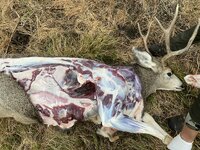Preferably the former. But I would honestly take both. See how much a .4 G7 bullet drifts at 3100fps with a quartering 8mph wind. Hold 5” right of the bullseye and its landing within that 10” span to the left, more than likely, despite any wind variances. Theres a fair bit of forgiveness at 500 yards honestly.
That’s a good point. The ballistics of the chosen tool matters.
Consider my choice, a .613 G1/.315 G7 BC at 3100 fps.
You can’t get much higher BC with minimal recoil pushing a 133 gr 25 cal Berger in a 10 pound rifle.
My confidence level is related to that. I know my choice buys me a bigger danger space and margin of error. Also assuming the position is solid and the wind isn’t gusting.
If you are shooting a 6.5 creedmoor, 7-08, .308, etc. then you’ve got less margin of error.
Math for math sake how I thought about my choice of caliber, bullet, and cartridge.
A wind call error of 3 mph full value wind is only 2.8 inches at 500 yards. A 4 mph error is 4.1 inches.
If my gun is a legit 1moa rifle in the field position, the vast majority are going to be within 3/4 moa, and half of them are going to be into the wind.
So, at 500 yards on a 10” target with a 1 moa rifle system including the shooter, let’s stack the error of widest lateral dispersion with the wind, which is only half MOA or 2.5 inches to the side of the aim point, plus a full 3 mph bad wind call of 2.8 inches. A .3 inch miss but the bullet is .257, so the miss is by half of .257- 3”. Yeah, it misses the plate by a hair. My point is that the wound channel of a Berger Elite Hunter is an inch or two into the hypothetical 10” vitals.
The odds of a hit with a 3mph wind error and 1 moa system are extremely high, by the math and the assumptions.
If you consider fully half of the shots will be into the wind from the aim point, then even a 4 mph error of 4.1 inches is still on the plate. A good portion of the misses of a 1 moa system are vertical as well, so you have another .9 inches with the dispersion of bullets into the wind.
For the number of shots under the bell curve of a 1 moa distribution, the animal with a 10” vital will still be dead with high probability, because only the misses with the wind will drift off the target.
Now, that’s just math, but that shows that it’s not impossible IF a shooter can zero the rifle and build a position, break the trigger cleanly, and manage recoil to keep dispersion to one moa in a solid field position.
This also shows, and I t’s been repeated here, if you are shooting your gun one MOA, you are killing. It’s practice you need in the field and in the heat of the moment.

